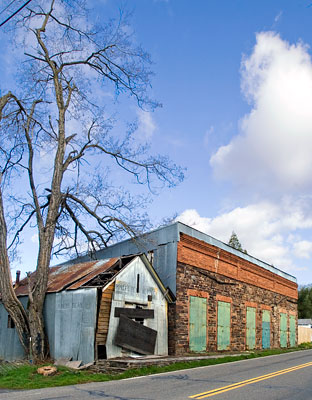National Register of Historic Places in Tuolumne County
Gamble Building and Miner's Bean Kettle
17544 State Route 120
Big Oak Flat
Gamble Building Built in 1852
Miner's Bean Kettle Built c1870
The Gamble Building is one of the oldest buildings in Tuolumne County and continuously served Big Oak Flat from the 1850s until the 1930s.
It is one of the finest examples of Gold Rush stone commercial architecture to be seen today, displaying splendid craftsmanship, with solidly constructed native slate stone walls accented by brick lined doorways and brick frieze. Located to the rear of the Gamble Building on the west side is a small stone and adobe room which served for a time as the community's jail.
When Big Oak Flat burned in 1863, only two buildings survived: the Gamble Building and the Odd Fellows Hall which is similarly constructed.
The wood frame building, known as the Miner's Bean Kettle since the 1920s, was built around 1870. It is one of only three wood frame buildings in Big Oak Flat built prior to the 1890s. The building has had few changes since its erection - chiefly the addition of corrugated metal siding and roofing - and provides insight into the simple but efficient commercial architecture of the 1870s. This building served as a residence and business facility until the 1940s.
By 1852 upwards of 3,000 people lived in and around the Big Oak Flat area. A sizable collection of permanent buildings soon surrounded the Gamble Building, including hotels, boarding houses, livery stables, restaurants and, of course, saloons. About a dozen of these buildings were constructed of stone or adobe, the rest were wood frame. Only a few buildings came near in size and value to Gamble's, none surpassed it.
The Gamble Building was an impressive architectural achievement with its fourteen foot high stone walls and brick detailing across the front. The stone and brick were obtained locally but the huge iron fire doors were reportedly packed in via mules.
From the 1850's until 1893, the Gamble Building housed a Wells Fargo Office.
Adapted from the NRHP nomination dated 16 November 1990.

Mining camps started as clusters of tents and other makeshift shelters. If the mine was productive, wooden buildings were erected and a town was born.
Conflagrations were a recurring curse. Often entire town were repeatedly destroyed by fire. Stonemasons, especially Italian immigrants from Liguria, began building "fire proof" banks and stores of stone or brick with iron doors and iron window shutters to protect the contents from fire.
Many of these stone buildings survive. Some of them, such as the Butte Store, are the sole reminders of a lost mining town.
Some of these buildings are:
Butte Store in Amador County
Calabozo in Hornitos
Civil War Armory in Georgetown
Compere Store in Murphys
Downieville Museum in Downieville
Fountain & Tallman Soda Works in Placerville
Gamble Building in Big Oak Flat
Hirshfeldter Building in Downieville
Honigsberger Store in Copperopolis
Italian Store in Douglas Flat
Kohler Store in Washington
Mackerman & Company Building in Downieville
Masonic Lodge in Columbia
Masonic Lodge in Hornitos
Nevada Brewery in Nevada City
Nevada Theatre in Nevada City
Odd Fellows Hall in Big Oak Flat
Old Segale Building in Murphys
Old Stone Garage in Truckee
Plymouth Trading Post in Plymouth
Pearson Soda Works in Placerville
Sam Choy Store in Angels Camp
Stage Stop in La Grange
Valente Building in Murphys
Watts & Tannahill Company Store in Groveland
Wells Fargo Bank and Stage Stop in Georgetown
Wells Fargo Express in Chinese Camp
Wells Fargo Express in French Corral
Wells Fargo & Company in North San Juan
